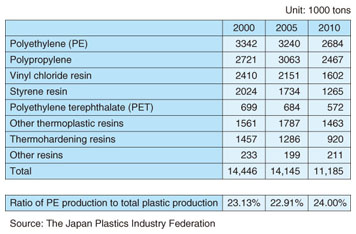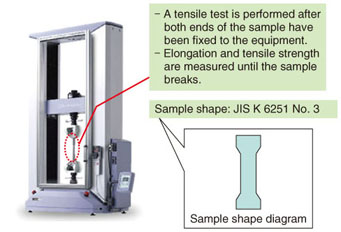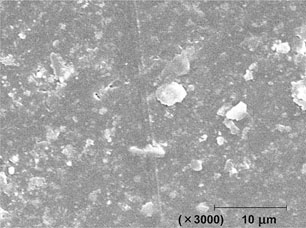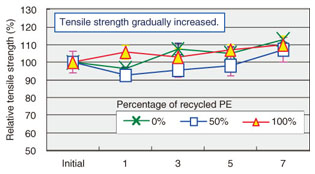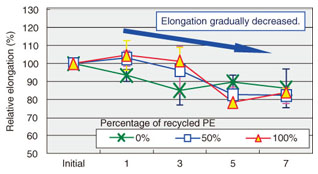 |
|
|
|
|
|
Practical Field Information about Telecommunication Technologies Vol. 10, No. 12, pp. 83–86, Dec. 2012. https://doi.org/10.53829/ntr201212pf1 Weather-resistance Tests for Recycled PolyethyleneAbstractThis article reports on weather-resistance tests performed on recycled plastic materials by the Technical Assistance and Support Center to evaluate the effectiveness of resource-saving technologies. Since the formulation of the NTT Global Environmental Charter in 1991, the NTT Group has been increasingly committed to deploying resource-saving technologies in its telecommunication facilities toward a recycling-oriented society. In 2002, both NTT EAST and ˇˇNTT WEST began to deploy communication cables using recycled plastic materials collected during facility upgrading and to design facilities so that the communication infrastructure makes a positive contribution to global environment protection efforts. This is the fourteenth in a bimonthly series on the theme of practical field information about telecommunication technologies. This month's contribution is from the Materials Engineering Group, Technical Assistance and Support Center, Maintenance and Service Operations Department, Network Business Headquarters, NTT EAST. 1. IntroductionCommunication cables extend for a total of two million kilometers throughout Japan and new cable deployment in conjunction with facility upgrading continues on a daily basis. Plastic materials in communication cables are used for the cable jacket and for the dielectric layer between the signal line and ground line in metallic cable. In particular, polyethylene (PE) is widely used in communication cables because of its high shock resistance, superior electrical insulation properties, and low-loss characteristics as an insulator. PE is the leading type of plastic produced in Japan (Table 1). There has been much interest in ways of recycling some of the base material from spent PE in order to save resources, and many manufacturers are pursuing the development of PE recycling technologies. The NTT Group has to deal with a huge amount of communication cables, and the use of recycled PE in communication cables could make a big contribution to the creation of a recycling-oriented society from the viewpoint of resource saving. With this in mind, the NTT Group has been promoting the deployment of cables using recycled PE.
2. Weather-resistance test for recycled plastic materials2.1 Test conditionsMany types of communication facilities require long-term reliability of 10 years or more. These include communication cables, which are used for long periods of time after initial installation, so long-term reliability is a requirement. In addition, communication cables must be deployable in a variety of environments including communication buildings, underground tunnels, and outdoor settings. It is generally known that PE deteriorates under ultraviolet light and heat. Thus, when PE is intended to be used for the communication cable jackets, its long-term reliability in an outdoor environment is an important issue. Before recycled communication cables using recycled PE for their outer jackets are deployed, they are checked to determine whether they pass standard performance tests with respect to weather resistance. However, their weather-resistance characteristics should be checked in real environments when facilities are being studied to ensure that they will exhibit high reliability and when maintenance plans are being formulated. Weather-resistance testing data is also extremely valuable for facility optimization design work, which is an ongoing endeavor. Consequently, the Technical Assistance and Support Center has been planning outdoor exposure experiments targeting recycled PE in actual environments and is currently conducting a verification experiment on the long-term reliability of cable outer jackets using recycled material. The plan for this verification experiment is outlined below. (In this article, we report on deterioration characteristics for exposure periods up to 7 years.) 1) Exposure periods/location: Samples shall be exposed in an outdoor environment at a location in Okinawa for fiscal years 2004–2014 and shall be collected and evaluated 1, 3, 5, 7, and 10 years after installation. The experimental setup for outdoor sample exposure is shown in Fig. 1.
2) Evaluation standards and items: A tensile test conforming to in-house standards shall be performed to evaluate tensile strength and elongation. 3) Samples: Samples having 0%, 50%, and 100% recycled material shall be prepared for comparison purposes. A sample shall be in the form of a sheet 1.0 mm thick. 4) Tensile test: From a sample sheet that has been subjected to the exposure test for a scheduled number of years, No. 3 test specimens conforming to JIS K 6251 shall be punched out and subjected to a tensile test at a speed of 200 mm/min using a high-precision, universal testing machine (Shimadzu Scientific Instruments Autograph AG-X (Fig. 2)). The number of samples per test shall be 5.
2.2 Test results (for 7-year test)This section presents the results of weather-resistance tests obtained to date for samples exposed for several periods up to 7 years. Using the pre-exposure-test characteristics of the samples for reference, we examined the changes in these characteristics after the test. Specifically, we took a sample that had been subjected to the exposure test for the specified time period and first made a visual inspection of its surface. We then evaluated the sample's rate of elongation and tensile strength by means of a tensile test. 1) Visual surface inspection: We found that samples collected from the exposure-test site had become distorted from their original shape. We also noticed that they retained their sheen (Fig. 1 (right)) and that no significant traces of ultraviolet-light deterioration were evident. A scanning electron microscopy image of the surface of a sample exposed in an actual outdoor environment for 7 years is shown in Fig. 3. The magnification is ×3000. While some unevenness could be seen in the sample's surface, no cracks or similar defects could be observed on the surface despite the long exposure.
2) Tensile test: We collected samples exposed for each of the scheduled test periods and subjected them to a tensile test. Results are shown in Figs. 4 and 5.
Figure 4 plots the average value and variation (indicated by an error bar) for five samples of the relative fracture strength (as a percentage of the initial value) after each scheduled exposure period. These results show that the tensile strength of the sample PE gradually increased as the sample deteriorated through exposure. This indicates that a sample of this material hardens as a result of deterioration, which is how ordinary PE behaves when left to deteriorate. Figure 5 plots the change in the magnitude of elongation at sample fracture (as a percentage of the initial value) for each exposure period. The vertical axis shows the relative elongation. The change over the 7-year period shows that the amount of elongation tended to decrease as deterioration progressed. We conclude that the material's hardening with deterioration made elongation increasingly difficult, which is the same behavior as shown by ordinary PE. A comparison of sample characteristics for different mixing ratios of recycled materials (0%, 50%, and 100%) showed no substantial observable differences in tensile strength or elongation retention. Moreover, for all mixing ratios, the elongation rate of freshly produced recycled material (data not shown) sufficiently exceeded the valued specified in the domestic standard for using such material for a communication cable outer jacket (NTT-required elongation rate: 400% or greater). The above results show that using recycled PE for communication cable outer jackets in an outdoor environment presents no problems in long-term use of at least 7 years. 3. SummaryIt has been 10 years since NTT EAST and NTT WEST began to use recycled PE in the outer jackets of metal cable used for communication purposes. Fortunately, there have been no field reports of problems with recycled PE, which suggests that the weather-resistance standards applied at the time of deployment were valid. We think that the data presented in this report reinforces the validity of those standards. Specifically, the results of our study show that recycled PE used in outdoor communication facilities has stable characteristics for at least 7 years in actual environments. The NTT Group in involved in a variety of activities for reducing environmental load. We think that the straightforward material evaluation described in this report is an important means of judging the validity of such activities and of providing valuable data for improving facility technologies in the future. 4. Concluding remarksWe presented the results of weather-resistance tests for recycled PE used in communication cable outer jackets. We hope that the information provided here contributes to the reader's understanding of communication-facility materials. In addition to tests related to the materials introduced here, the Technical Assistance and Support Center is also investigating problems in facilities and equipment with undetermined causes. If you have a problem that cannot be explained, please consult with us at the Technical Assistance and Support Center. |
|









